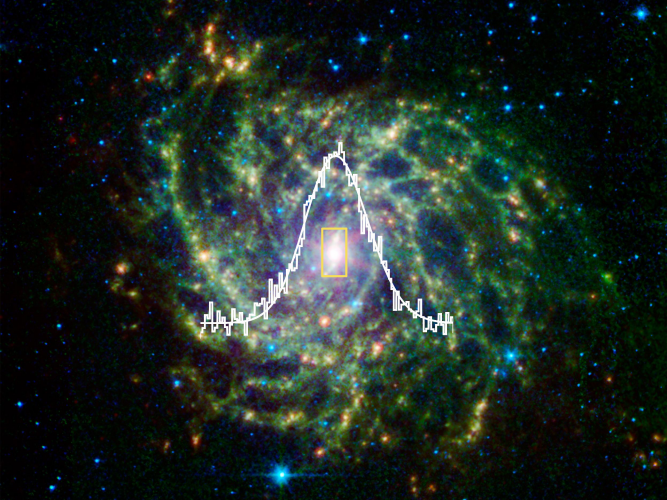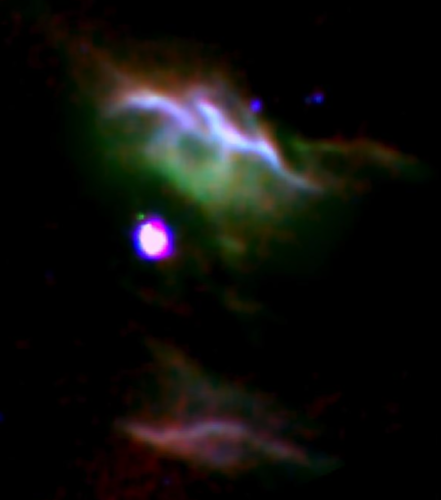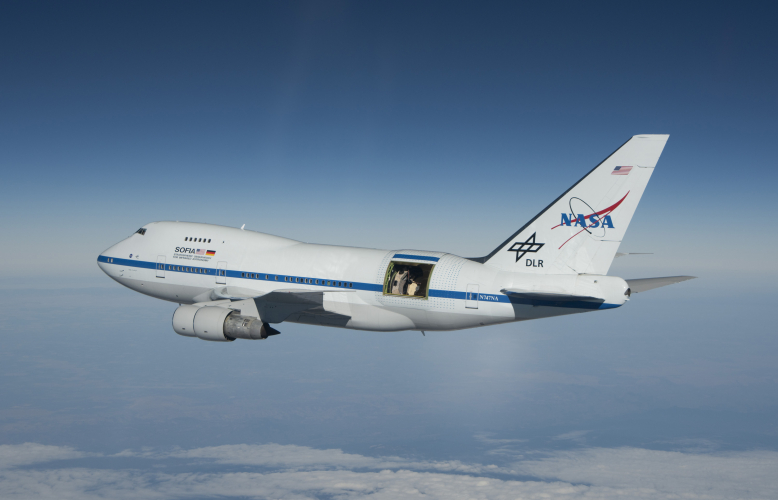Science Results Archive
| Spotlight | Image |
|---|---|
|
Understanding Star Formation in the Nucleus of Galaxy IC 342
An international team of researchers used NASA’s Stratospheric Observatory for Infrared Astronomy, SOFIA, to make maps of the ring of molecular clouds that encircles the nucleus of galaxy IC 342. The maps determined the proportion of hot gas surrounding young stars as well as cooler gas available for future star formation. The SOFIA maps indicate that most of the gas in the central zone of IC 342, like the gas in a similar region of our Milky Way Galaxy, is heated by already-formed stars, and relatively little is in dormant clouds of raw material. |

|
|
SOFIA Undergoing Engine Maintenance
On April 12, during a test of SOFIA’s systems involving an engine run, an anomaly occurred calling into question the flight-worthiness of Engines 1 and 4. The SOFIA maintenance team is investigating this issue. In the interim, program management has made a decision to replace the engines with spare engines. The observatory will resume flights after safety and engineering checks are completed. This down time has resulted in the estimated loss of at least eight science flights. |

|
|
SOFIA Confirms Nearby Planetary System is Similar to Our Own
NASA’s flying observatory, the Stratospheric Observatory for Infrared Astronomy, SOFIA, recently completed a detailed study of a nearby planetary system. The investigations confirmed that this nearby planetary system has an architecture remarkably similar to that of our solar system. |

|
|
Don’t Judge an Asteroid by its Cover: Mid-infrared Data from SOFIA Shows Ceres’ True Composition
New observations show that Ceres, the largest body in the asteroid belt, does not appear to have the carbon-rich surface composition that space- and ground-based telescopes previously indicated. |

|
|
NASA Flying Observatory Makes Observations of Jupiter Previously Only Possible from Space
For the first time since the twin Voyager spacecraft missions in 1979, scientists have produced far-infrared maps of Jupiter using NASA’s Stratospheric Observatory for Infrared Astronomy, SOFIA. These maps were created from the researchers’ studies of the circulation of gases within the gas giant planet’s atmosphere. |

|
|
First Images Demonstrate the Capabilities of SOFIA’s New Instrument
This is the first polarization image from the Stratospheric Observatory for Infrared Astronomy’s new infrared camera and polarimeter, known as the High-resolution Airborne Wideband Camera-plus (HAWC+). Polarimeters measure the alignment of incoming light waves, enabling HAWC+ to map magnetic fields in star forming regions. |

|
|
SOFIA Sees Super-Heated Gas Streams Churning up Possible Storm of New Stars
Scientists on board NASA’s flying telescope, the Stratospheric Observatory for Infrared Astronomy, or SOFIA, caught sight of roiling material streaming from a newly formed star, which could spark the birth of a new generation of stars in the surrounding gas clouds. |

|
|
NASA’s Flying Observatory Expanding New Frontiers in the Solar System and Beyond
NASA’s Stratospheric Observatory for Infrared Astronomy, SOFIA, will soon be studying Neptune’s giant moon, Triton, and following-up on Hubble’s recent sighting of water plumes on Jupiter’s moon Europa. According to recently completed plans for the 2017 observing campaign, about half of the research time for SOFIA will run the gamut from studies of planets to observations of comets and asteroids orbiting other stars and supermassive black holes in the centers of galaxies beyond our own. |

|
|
Fireworks for birth of massive stars
An international scientific team led by Dr. Alessio Caratti o Garatti from the Dublin Institute for Advanced Studies (Ireland) for the first time observed and analyzed an outburst from a high-mass young stellar object that was caused by material accreting onto the star. |

|
|
SOFIA Detects Collapsing Clouds Becoming Young Suns
Researchers on board NASA’s Stratospheric Observatory for Infrared Astronomy, SOFIA, observed the collapse of portions of six interstellar clouds on their way to becoming new stars that will be much larger than our sun. When a gas cloud collapses on itself, the cloud’s own gravity causes it to contract and the contraction produces heat friction. Heat from the contraction eventually causes the core to ignite hydrogen fusion reactions creating a star. |

|
|
NASA Selects Next Generation Spectrometer for SOFIA Flying Observatory
A team from NASA’s Goddard Space Flight Center in Greenbelt, Maryland, has been selected to develop a new, third-generation facility science instrument for the Stratospheric Observatory for Infrared Astronomy, SOFIA. |

|
|
“Kitchen Smoke” Molecules in Nebula Offer Clues to the Building Blocks of Life
Using data collected by NASA’s Stratospheric Observatory for Infrared Astronomy (SOFIA) and other observatories, an international team of researchers has studied how a particular type of organic molecules, the raw materials for life – could develop in space. This information could help scientists better understand how life could have developed on Earth. |

|
|
SOFIA Heads to New Zealand to Study Southern Skies
The Stratospheric Observatory for Infrared Astronomy, SOFIA, arrived in Christchurch, New Zealand, to study the Southern Hemisphere’s skies June 6. |

|
|
NASA and German Aerospace Center Extend SOFIA Cooperative Agreement
NASA and the German Aerospace Center, DLR, have extended their agreement to continue Stratospheric Observatory for Infrared Astronomy, SOFIA, science observations until the end of 2020. The renewal agreement was signed on June 2, 2016, at the ILA Berlin Air Show by Dava Newman, deputy administrator of NASA, Pascale Ehrenfreund, chair of the DLR Executive Board, and Gerd Gruppe, member of the DLR Executive Board responsible for Space Administration. |

|
|
One-of-a-Kind Camera Added to SOFIA
The newest instrument, an infrared camera called the High-resolution Airborne Wideband Camera-Plus (HAWC+), was installed on the Stratospheric Observatory for Infrared Astronomy, SOFIA, this week. This is the only currently operating astronomical camera that makes images using far-infrared light, allowing studies of low-temperature early stages of star and planet formation. HAWC+ includes a polarimeter, a device that measures the alignment of incoming light waves. |

|
|
SOFIA Witnesses the Emergence of a Carbon Star
The planetary nebula BD+30 3639 was imaged by SOFIA using FORCAST (Faint Object InfraRed Camera for the SOFIA Telescope; P.I. T. Herter, Cornell University) at wavelengths of 6.4, 7.7, 11.1, 11.3, and 33.6 microns. BD+30 3639 (also known as PN G064.7+05.0) is located at a distance of 1.2 kiloparsecs. |

|
|
SOFIA/GREAT Detection of Atomic Oxygen in the Martian Atmosphere
Atomic oxygen is a key component in regulation of energy and mass exchanges within the Martian atmosphere. Neutral atomic oxygen (O I) was detected in the Martian atmosphere at a frequency of 4.7 THz (63 μm) on 14 May 2014 using the high-frequency channel of the far-infrared heterodyne spectrometer GREAT (German Receiver for Astronomy at Terahertz Frequencies; P.I. Rolf Güsten, Max Planck Institut für Radioastronomie) onboard SOFIA. The [O I] line was found in absorption against the Mars continuum with a high signal-to-noise ratio (see figures). |
![SOFIA/GREAT [O I] spectrum at 4.7 THz (63 μm) superimposed on a picture of Mars. SOFIA/GREAT [O I] spectrum at 4.7 THz (63 μm) superimposed on a picture of Mars.](/data/SOFIA/docs/sites/default/files/styles/lightboxgallery_height_500/public/MarsGREAT.jpg)
|
|
SOFIA Begins Its Fourth Annual Cycle of Science Flights
The Stratospheric Observatory for Infrared Astronomy, or SOFIA, began its fourth annual cycle of science flights on February 3, 2016. SOFIA is a heavily modified Boeing 74SP jetliner that carries a 100-inch (2.5-meter) telescope to altitudes between 39,000 to 45,000 feet (12 to 14 km), above more than 99 percent of Earth's atmospheric water vapor, giving astronomers the ability to study celestial objects at infrared wavelengths that cannot be seen from ground-based observatories. |

|
|
SOFIA Science Session at Winter 2016 American Astronomical Society Meeting
Science results from NASA’s Stratospheric Observatory for Infrared Astronomy were featured in a special session held at the American Astronomical Society’s annual meeting, Jan. 8, 2016, in Kissimmee, Florida. The airborne observatory reached full operational status in May 2014; the fruits of its early science programs are beginning to be available to the scientific community. |

|
|
NASA SOFIA Third Generation Science Instrument Selection Enters Final Phase
The competition to develop a third generation instrument for the Stratospheric Observatory for Infrared Astronomy (SOFIA) has been narrowed to two proposed instruments. Over the course of the next few months, the two proposal teams will work to produce detailed concept studies. Based on those studies, one of those instruments will be selected to begin development by Fall 2016, with a targeted completion date in 2018. Both of the proposed instruments are intended to expand the SOFIA airborne observatory’s spectroscopic capabilities. |

|